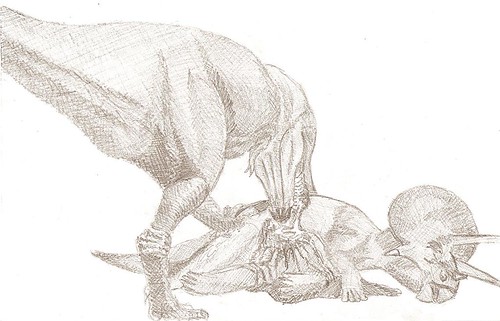T-rex Feeding on a Triceratops Carcass,
But did he Kill the Triceratops, or Find it?
Tyrannosaurs were giant predatory theropods that lived during the very end of the age of the dinosaurs. Monstrous beasts that terrorized the landscape and killed any unfortunate herbivore they happened to come across. Huge and fast, equipped with banana sized teeth and jaws that could bring down prey with a single, bone-shattering bite; these must’ve been the top predators of their environment. Or were they?
Some scientists have questioned the idea that Tyrannosaurs were top predators, but instead quote many unnoticed features about their anatomy. Tiny useless arms not useful for hunting, bone-crushing jaws for extracting marrow, bodies that were too large and legs to thick to sustain a very fast running speed. All these traits seemed to be pointing towards T-rex and its relatives to not be predators, but something else; Scavengers.
This has been a reoccurring topic for many years now; it is one of the longest running debates in paleontology. Although much of the public and the majority paleontologists find Tyrannosaurs to likely be active predators, both sides have substantial amounts of evidence for their own cases. I can say though, when I first learned about this theory, I went mad.
I first heard about it when I watched the BBC Horizon documentary T-rex: Warrior or Wimp when I was about 6 or 7. I completely hated the idea; I knew they must be wrong; T-rex was a cold-blooded killer that could kill and eat anything it wanted. Jurassic Park and all those other scientists couldn’t have gotten it wrong, could they?
The years went by and I continued to believe T-rex and other Tyrannosaurids were powerful predators, chasing down game on a prehistoric Serengeti, and brawling with herbivores like a prehistoric version of Godzilla. However, that all changed as I continued to grow and mature. I began going back to the Scavenger Hypothesis as I continued to learn about T-rex.
As I looked the facts over and over again, I started to understand where the other scientists' reasoning was coming from. Some of the things I just assumed weren’t actually true, and my own ideas were replaced by scientific facts. I learned how T-rex’s body worked, learned about its anatomy and habits, and even learned many problems found in the Predator hypothesis as well as the Scavenger one. For a short time, even I, the little kid that couldn’t accept T-rex as being anything less than a monster, started to consider T-rex to be a scavenger.
I continued to learn about more and more theories on the monster. New evidence would continue to pop up for both sides claims, and my own mind was being pulled into different direction over what T-rex and its kin were actually like. Some scientists like Dr. Bob Bakker Considered T-rex to be a Hunter, other scientists like Dr. Jack Horner thought it to be a scavenger, and some scientists even proposed that ist was a little bit of both.
As time went on I started shift between the theories every once and a while. At the moment I’m at one of the point where I can’t find out myself, and that’s where this topic comes into play. Since I’ve had such a long history learning about T-rex and its kin, I've decided that this should be one of my first topics to look over and finally try to see what T-rex did to get a meal.
For the next few weeks, I'll be investigating deeply into Tyrannosaur anatomy to find out exactly what their feeding strategies were like, and how they sustained their bodies. What conclusions I make are entirely my opinion based on scientific facts I’ve learned about over the years. So, let's find out where T-rex and it's kin belong on the food chain, shall we?

No comments:
Post a Comment